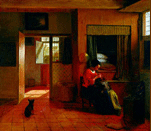










13.
"Conceived unto herself":
Maternal Influence in the Patriarchial Home
Organizers:
We will be dividing the workshop time into three 30-minute discussion periods, each centering on a different aspect of maternal influence. We expect that participants will bring their own interests, comments and questions to our discussions and that they will determine the questions that we ultimately pursue as a group. We will begin the workshop by examining the question of mothers as spiritual influences on their children. Caroline Johnson Hodge will mediate this part of the discussion. We will use readings on ancient Roman households and early Christian discussions of the mother’s role in saving or polluting her children’s souls as a starting point to a broader discussion of maternity and religious influence in the early modern period. Many of the ideas about the power of breast-feeding and maternal role-modeling over the spiritual growth of children that we will see in these ancient texts are reiterated in the humanist and biblical texts of sixteenth- and seventeenth-century Europe as well as in the spate of mother’s advice books written for the spiritual instruction of their children. We envision that this opening discussion time will provide us with an important starting point for exploring the early modern debate over the influence of mothers, as well as other domestic women such as nurses and servants, on the spiritual growth of a household’s children.
The second part of our discussion will focus on the theme of female influence over the physiological process of generation. Katharine Park will mediate this brainstorming session as we consider excerpts from fifteenth-century Italian medical treatises, domestic advice manuals, autopsy reports and diaries that all focus on the woman’s role in shaping the body of her offspring. While many official documents, formal genealogies, and medical and theological treatises emphasized the father’s contribution to generation, to the exclusion of the mother’s, other texts suggested that the maternal contribution could also be important in the physiology of generation, serving specifically to mould the complexion and conformation of the child. Possible questions to pursue would be: How did women understand these ideas of female inheritance? What tensions between maternal and paternal influence do these texts articulate? Again, the interests of the participants will shape our discussions throughout.
Having explored both the spiritual and physiological legacies that mothers left to their children, the group will then pursue the issue of how the maternal imagination was believed to shape the bodies and characters of fetuses in utero. Such stories were not unique to early modern England, although the textual examples we will be examining are taken from that time (including excerpts from mother’s advice manuals and medical handbooks). Caroline Bicks will mediate this part of the discussion, which we anticipate might include questions about how early modern men and women negotiated the unique power of the maternal imagination one that was often described as being out of the mother’s control but at other times rivaled that of men’s imaginative faculties. Mothers could, for example, determine whom their children would resemble by imagining a particular man at the time of conception. This possible destabilization of racial and patriarchal categories is a fruitful topic for exploration. Robert Burton acknowledged the disposable nature of the father in this process when he wrote that the mother imprints that stamp upon her child, which she conceived unto herself. These two models of the imagination as passive and active were in obvious tension as men grappled with a concept of autonomous female creativity that they themselves had perpetuated.
Recommended Readings:
|
|
|
||||||
|
|
 |
 |
|
||||
 |
|
 |
|
||||
|
|
|
||||||
|
|
|
||||||
 |
|
||||||
|
|
|
||||||
| |
|
||||||
 |
|
||||||
 |
|
||||||
 |
|
||||||
 |
|
||||||
|
|
|
||||||
|
|
 |
|
|
||||
 |
|
||||||
|
|
|
|
|
|
|
|
|